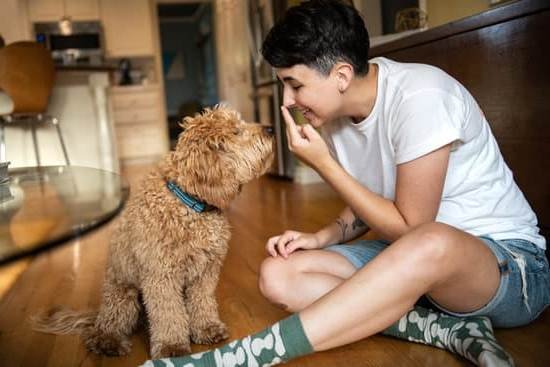How To Train Your Dog As A Psychiatric Service Dog
A psychiatric service dog can provide invaluable support to someone living with a mental health condition. They can help reduce anxiety, provide comfort, keep people safe, and perform other tasks that make life easier. But before you can bring your new service dog home, you need to train them.
Train your dog using positive reinforcement techniques. This means rewarding them for good behavior with treats, petting, or verbal praise. When your dog does something you want them to do, such as following a command or behaving calmly in a stressful situation, reward them immediately.
Start with basic obedience commands such as sit, stay, come, and down. Be consistent with your commands, and make sure to reward your dog each time they obey. As your dog becomes more comfortable with these commands, you can start to ask them to perform them in more challenging situations.
Train your dog to stay calm in stressful situations. This may involve exposing them to different types of noise or crowds, or asking them to remain calm when someone is acting out. If your dog becomes agitated or starts to bark, calmly interrupt them and redirect them to a behavior you want them to perform.
Teach your dog to perform helpful tasks. A psychiatric service dog can be trained to do things like open doors, bring you objects, or provide physical support. Start with basic tasks and then gradually increase the difficulty as your dog becomes more comfortable.
Ensure that your dog is socialized and well-behaved around other people and animals. Psychiatric service dogs can provide vital support to their handler, but they also need to be able to interact politely with others. Make sure your dog is comfortable meeting new people and animals, and always reward them for good behavior.
Train your dog for at least a year before you use them as a psychiatric service dog. This will give them enough time to learn all the necessary commands and behaviors, and will help to ensure that they are well-behaved in public.
A psychiatric service dog can provide invaluable support to someone living with a mental health condition. They can help reduce anxiety, provide comfort, keep people safe, and perform other tasks that make life easier. But before you can bring your new service dog home, you need to train them.
Train your dog using positive reinforcement techniques. This means rewarding them for good behavior with treats, petting, or verbal praise. When your dog does something you want them to do, such as following a command or behaving calmly in a stressful situation, reward them immediately.
Start with basic obedience commands such as sit, stay, come, and down. Be consistent with your commands, and make sure to reward your dog each time they obey. As your dog becomes more comfortable with these commands, you can start to ask them to perform them in more challenging situations.
Train your dog to stay calm in stressful situations. This may involve exposing them to different types of noise or crowds, or asking them to remain calm when someone is acting out. If your dog becomes agitated or starts to bark, calmly interrupt them and redirect them to a behavior you want them to perform.
Teach your dog to perform helpful tasks. A psychiatric service dog can be trained to do things like open doors, bring you objects, or provide physical support. Start with basic tasks and then gradually increase the difficulty as your dog becomes more comfortable.
Ensure that your dog is socialized and well-behaved around other people and animals. Psychiatric service dogs can provide vital support to their handler, but they also need to be able to interact politely with others. Make sure your dog is comfortable meeting new people and animals, and always reward them for good behavior.
Train your dog for at least a year before you use them as a psychiatric service dog. This will give them enough time to learn all the necessary commands and behaviors, and will help to ensure that they are well-behaved in public.
How To Get A Ptsd Trained Service Dog
The process of getting a PTSD Service Dog can be long and difficult, but it is well worth it in the end. The first step is to find a reputable service dog organization. There are many of these organizations throughout the United States, so it is important to do some research to find the one that is the best fit for you and your needs.
Once you have found a service dog organization, the next step is to complete an application. This application will ask for information about yourself, your medical history, and your current living situation. It is important to be as honest as possible on this application, as the organization will use this information to determine if you are a good fit for a service dog.
If the organization determines that you are a good fit for a service dog, they will then begin the process of matching you with a dog. This process can take a long time, as the organization wants to make sure that you are matched with the perfect dog for your needs.
Once you have been matched with a dog, the next step is to complete a training program. This program will teach you how to work with your service dog and will help to create a strong bond between you and your dog.
The final step is to get your service dog certified. This certification will ensure that your dog has been properly trained and is capable of providing assistance to you.
How Can A Dog Be Trained As A Service Dog
Service dogs are amazing animals that are specially trained to help people with disabilities. They can help with everything from picking up things that have been dropped to guiding people who are visually impaired. But how can a dog be trained as a service dog
The first step in training a dog to be a service animal is to assess its temperament. Dogs that are shy or aggressive are not good candidates for service dog training. The next step is to begin basic obedience training. A service dog needs to be able to obey basic commands like sit, stay, and come.
Once the dog has mastered basic obedience, the next step is to train it to perform specific tasks that will help its owner. This may include tasks like fetching things for the person with a disability, opening doors, or pulling a wheelchair.
It takes a lot of time and effort to train a dog to be a service animal. But it is well worth it when you see the positive impact that these dogs can have on the lives of their owners.
Does Voca Pay For Service Dog Training
The answer to this question is a resounding, “It depends.” Service dog training can be quite expensive, and many people may wonder if Voca offers any financial assistance in this area.
The fact is, Voca does not directly pay for service dog training. However, the company may be able to help offset some of the costs associated with this process.
One way Voca can help is by providing a monthly stipend to help cover the cost of food and other necessary items for the dog. Additionally, Voca may be able to help finance the purchase of a service dog if the individual meets certain criteria.
Ultimately, the decision of whether or not to train a service dog is a personal one. However, Voca is committed to helping employees with disabilities in any way possible, and this may include assistance with the costs of service dog training.
How To Train My Rottweiler To Be A Service Dog
There is a great deal of confusion surrounding the role of service dogs. Some people seem to think that service dogs are only for people with physical disabilities, while others believe that they can be used to help with any type of mental health issue. The truth is that service dogs can be extremely helpful for people with a wide range of disabilities, including mental health issues.
If you are considering training your Rottweiler to become a service dog, there are a few things you should know. First of all, it is important to understand the difference between a service dog and an emotional support animal. Service dogs are specifically trained to perform tasks that help their handler live a more independent life. This might include things like retrieving items from the grocery store, opening doors, or helping the handler get up from the floor. Emotional support animals, on the other hand, are not specifically trained to do anything. They are simply there to provide comfort and support to their handler.
If you are interested in training your Rottweiler as a service dog, you will need to find a qualified dog trainer. It is important to find a trainer who specializes in service dogs, as the training process can be quite complex. The trainer will help you to train your dog to perform specific tasks that will help you live a more independent life. In addition to training, the trainer will also provide you with information on how to work with your dog in public and how to handle any challenges you may encounter.
If you are looking for a service dog that is specifically trained to help with mental health issues, it is important to find a dog that has been trained to work with people with disabilities. Not all dogs are suited for this type of work, so it is important to do your research before you begin training.
Training a Rottweiler to be a service dog can be a challenging but rewarding experience. If you are dedicated to the process and have the patience to work with your dog, you can create a bond that will last a lifetime.

Welcome to the blog! I am a professional dog trainer and have been working with dogs for many years. In this blog, I will be discussing various topics related to dog training, including tips, tricks, and advice. I hope you find this information helpful and informative. Thanks for reading!





